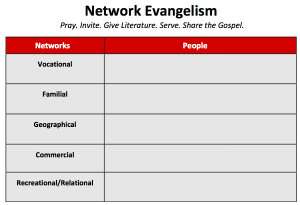“If you build it, they will come.”
I like the movie Field of Dreams, but it’s a terrible evangelism strategy for church planters.
Most unbelievers have no interest in joining you this Sunday. Simply offering a “good product” isn’t enough in this post-Christian world. It doesn’t matter how cool your venue is, how good your music and coffee are, or how hip your pastor looks.
The unbelievers who do show up are there because someone has befriended and invited them outside the walls of a church building. Most outsiders aren’t waking up saying, “I wonder if they have good coffee. I’m going to check it out.” Or “I bet the music is great there. I should go visit.”
As church-planting pastors, we have to overemphasize evangelism. It’s a challenge for us to be both missional and also pastoral—a tension that exists from the founding of your church. One planter recently told me, “I just got started, and I already have shepherding issues.”
But if a church is to flourish, evangelism must be central to the life of the body.
Models of Evangelism
In years past, two forms of evangelism have been most common: event evangelism and cold-call evangelism. Indeed, when people hear “evangelism” today, they often think of either big events/crusades or door-to-door outreach.
The Lord has used both of these approaches, and in some contexts, they continue to be effective. However, in other places—particularly in many post-Christian contexts—these approaches are often less fruitful.
I don’t want to insinuate we should reject these approaches. We shouldn’t. But I want to highlight another approach that has historic precedent—one that is both culturally appropriate and personally achievable: network evangelism.
Network evangelism isn’t an event; it’s not a program; it’s not something you only do on Tuesday nights at 6 p.m. It’s a lifestyle.
Network evangelism isn’t an event; it’s not a program; it’s not something you only do on Tuesday nights at 6 p.m. It’s a lifestyle. It’s about living with gospel intentionality in the everyday rhythms of life. It’s done among the people who fall into your current web of relationships.
When planting a church, network evangelism becomes a practical way to emphasize how every member can live as a missionary.
In order to cultivate and sustain an evangelistic culture in our young church, I’ve preached a number of sermons on this topic. The first series came after the elders had a long discussion about why we weren’t seeing more people converted. As I was praying and thinking about how to lead our people, I came across this statement in Tim Keller’s Church Planter Manual:
There must be an atmosphere of expectation that every member will always have two to four people in the incubator, a force-field in which people are being prayed for, given literature, brought to church or other events.
We’ve sought to expand and build on this idea.
Why Network Evangelism?
Network evangelism first recognizes the sovereignty of God. It develops a mindset that every person in our sphere of life matters, and it helps us remember that God has us living in this time and place in history, surrounded by particular image-bearers he has sovereignly put in our path (Acts 17:26).
Additionally, network evangelism has historic precedent. In his book Cities of God, sociologist Rodney Stark describes how Christianity became an urban movement that transformed the Roman world:
Social networks are the basic mechanism through which conversion takes place. . . . Most conversions are not produced by professional missionaries conveying a new message, but by rank-and-file members who share their faith with their friends and relatives. . . . The principle that conversions spread through social networks is quite consistent with the fact that the earliest followers of Jesus shared many family ties and long-standing associations. . . . Although the very first Christian converts in the West may have been by full-time missionaries, the conversion process soon became self-sustaining as new converts accepted the obligation to spread their faith and did so by missionizing their immediate circle of intimates.
Did you see that? The movement advanced because new converts accepted the obligation to spread the gospel within their own circles of everyday influence.
Further, network evangelism promotes faithfulness and patience. Evangelistic methods often involve only “on the spot” presentations. They can be impersonal as well. They can be about generating numbers, not valuing people. They can allow us to simply “check a box” to appease our guilt, and then move on.
In planting a church, network evangelism becomes a practical way to emphasize how every member can live as a missionary.
But when you’re reaching out to people you see regularly, it demands faithfulness and perseverance. You can do the necessary pre-evangelism, answer questions, slowly and gradually watch defenses go down, and hopefully—by God’s grace—see your friend, family member, co-worker, or neighbor declare, “Jesus is Lord.”
Who’s in Your Networks?
We could organize our web of relationships in a variety of ways, but it has been helpful for our church to think within five categories:
- Familial Network—people in your family.
- Geographical Network—people in your neighborhood.
- Vocational Network—people at your workplace.
- Recreational Network—people you hang out with.
- Commercial Network—people you see at shops.
We encouraged our church members to identify at least five people in each of these networks—or if they’re low in one area, to increase the number of people in the other networks. And we’ve encouraged them to do one of five tasks:
- Pray for them—You’ll be surprised what happens when you begin to pray for the people in your path. You may experience the joy C. S. Lewis expressed: “I have two lists of names in my prayers, those for whose conversions I pray and those for whose conversions I give thanks. The little trickle of transferences from List A to List B is a great comfort.”
- Invite them—Invite them over to eat dinner, to play sports, to go to a movie, to come with you to a church event.
- Serve them—Identify a way that you can bless those in your networks. Babysit for them, pick up groceries for them, cut their grass, and so on.
- Give resources to them—Ask them to read a book or article with you, or to listen to a sermon or podcast. Discuss these resources with them.
- Share the gospel with them—Look for various places where you can talk about your faith. Let your friend know you are part of a church, and see if they ask questions. Listen to their problems with real concern, and then seize the opportunity to address the problems with gospel hope. Share some of your own struggles, and talk about how you deal with them in light of your faith. Simply ask them what they believe, and just let them talk.
From this plan—five people in each of the five categories, doing one of the five tasks—we developed this evangelism card for individuals and small groups:

May God use ordinary saints like us, who overflow with love for the Savior, to lead outsiders to faith as we live with gospel intentionality in our everyday networks.

































